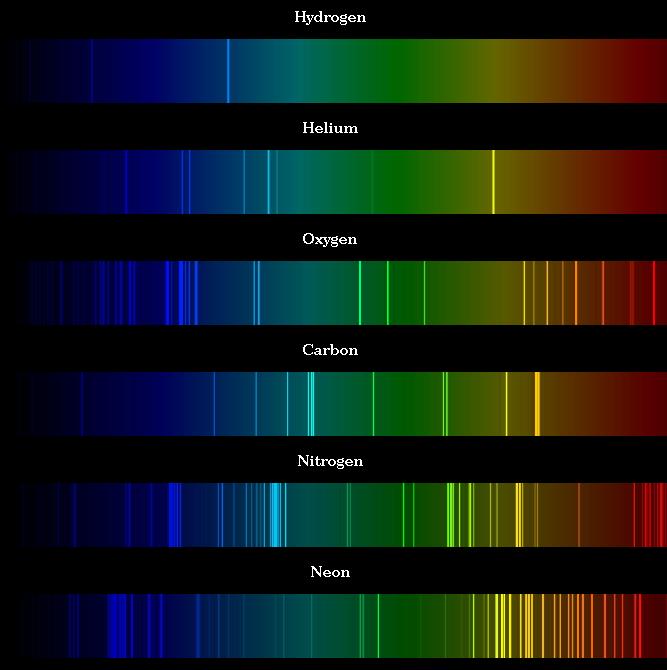Introduction to Astronomy
Observable Properties of Stars
Definition of a star: Stars are objects that get most of their energy from nuclear fusion. This is in direct contrast to objects like planets and asteroids, which get no energy from fusion, and clusters or galaxies which are collections of stars.
Stars have many observable properties, and we will talk about them one at a time.
- Location: We already talked about part of this. The location of the star in the sky is given by the Right Ascension and Declination. This gives you a unique way of pointing out the direction to the star. But something is missing---the depth, or distance of the star. We need to figure out how far away it is in order to know where it is in space. Distance is one of the most difficult things for astronomers to figure out, but it's very important. For example, if you don't know how far away the object is, you don't know how bright it is (intrinsically), or how large it is. There are four basic ways to determine distances in astronomy. Each of these methods is useful only over a certain range of distances. The accuracy of the methods drops off with distance, so that the closer the object, the better we know the distance, as a general rule.
- Radar: Radar is exactly what you think it is. A light beam is bounced off of an object. The amount of time that it takes for the light beam to go to the object and come back again is twice the light travel time to the object. So, for example, the Sun is 8 light minutes away (it takes light 8 minutes to get there). A radar observation of the Sun takes 16 minutes to complete, because the light has to go and return.
To use this method, an extremely powerful transmitter is required, as is a very sensitive receiver. In general, these experiments are carried out using the Arecibo Radio Telescope, which you may recognize from the movie 'Contact':
 This is because the signal gets weaker with distance (it spreads out), so that by the time it bounces off of the distant object, and comes back to us, it can be quite faint.
This method is most useful for very close objects, within our own solar system. Objects farther away than Saturn are too far away to use this method.
This is because the signal gets weaker with distance (it spreads out), so that by the time it bounces off of the distant object, and comes back to us, it can be quite faint.
This method is most useful for very close objects, within our own solar system. Objects farther away than Saturn are too far away to use this method.
- Parallax: Depending on your point of view, stars appear in different locations relative to background stars. To get a qualitative feel for how this works, hold your finger up in front of your face, and alternately close and open each eye. You will see your finger 'jump' back and forth relative to the background objects. The farther away you hold your finger, the less it 'jumps'. In astronomy, we do parallax either using the diameter of the Earth (for close things like planets), or using the diameter of the Earth's orbit (for more distant things like stars).
 The parallax angle of a star is related to the distance:
D(parsecs)=1/p(")
Where D is the distance in parsecs (1 parsec=3.26 light years), and p is the angle in arcseconds (abbreviated "). To try to get a sense of the scale of what we are measuring, one arcsecond is the angular size of a tennis ball eight miles away, and scientists are now routinely able to measure parallaxes of micro-arcseconds (10-6 or 0.000001 arcseconds) using radio telescopes.
The parallax angle of a star is related to the distance:
D(parsecs)=1/p(")
Where D is the distance in parsecs (1 parsec=3.26 light years), and p is the angle in arcseconds (abbreviated "). To try to get a sense of the scale of what we are measuring, one arcsecond is the angular size of a tennis ball eight miles away, and scientists are now routinely able to measure parallaxes of micro-arcseconds (10-6 or 0.000001 arcseconds) using radio telescopes.
- Standard Candles: To use a standard candle, you assume that all the objects of a particular type have a property in common. For example, you might assume that all spiral galaxies are the same size. Then, when you observe how the observed property is different from one object to the next, you get an estimate of the distance. There are two types of standard candles:
- Size: Assume that all the objects of a particular kind are the same size. Therefore objects which appear smaller must be farther away. You do this ALL THE TIME. Imagine you are at the top of the Bell Tower. You look down and see all the little people. You DO NOT SAY "Oh, look at that cute little guy, I'm going to pick him up and put him in my pocket." No. Instead you say "Wow, look how high up I am!" You have in your head a standard person size, and in general, when you see people much smaller than that, you assume they are far away.
- Brightness: Assume all objects of a particular kind are the same brightness. Therefore objects which are fainter are farther away. You also do this ALL THE TIME. Imagine that you are walking down the street, and you see headlights very faint in front of you. You DO NOT SAY "ACK!" and jump to the side to avoid the car with the extra-specially faint headlights. No. You say "That car is far away and I don't need to worry about it.
Standard candles can get us out to the nearest several dozen galaxies. A few million parsecs or so away.
- The Hubble Law: distances to the MOST DISTANT objects are found using the Hubble Law. I defer a detailed explanation of this til later. For now, it is sufficient to know that the Universe is expanding. More distant objects move away from us faster. So if we know how fast they are going, we know how far away they are.
So, those are our tools for figuring out the locations of stars (including the distance).
- Composition: You've probably often heard that stars (and, indeed most of the Universe) are mostly made of hydrogen. How do we know?! Well, stars are made of atoms, just like you and me. Recall from chemistry, the periodic table of the elements, and all that stuff about valence shells, metals and inert gases. Elements are particular kinds of atoms, and every element has it's own 'signature'---a set of colors that are particular to that atom. Here are a few of these signatures:
 We measure the wavelengths of these lines in a laboratory, and then look in the spectra of stars for the same patterns. When we find a particular pattern of lines in a star, we know that a particular kind of atom is present. The relative strengths of these lines can help us figure out HOW MUCH of a particular atom is present, relative to, say, the amount of hydrogen present.
In a heated gas, which is hot relative to what is behind it, these lines show up in emission, as shown above. However, when the atoms are in front of a hotter background, they absorb emission. An absorption spectrum looks like this:
We measure the wavelengths of these lines in a laboratory, and then look in the spectra of stars for the same patterns. When we find a particular pattern of lines in a star, we know that a particular kind of atom is present. The relative strengths of these lines can help us figure out HOW MUCH of a particular atom is present, relative to, say, the amount of hydrogen present.
In a heated gas, which is hot relative to what is behind it, these lines show up in emission, as shown above. However, when the atoms are in front of a hotter background, they absorb emission. An absorption spectrum looks like this:
 The bottom panel here just turns the top panel "on its side", plotting the brightness versus wavelength as a line. You can see that where the top panel spectrum is dark, the line in the bottom panel dips down. This makes it possible to measure the 'strength' of the lines. i.e. determine how much absorbing is going on. The bottom view is the way astronomers generally look at spectra nowadays.
The bottom panel here just turns the top panel "on its side", plotting the brightness versus wavelength as a line. You can see that where the top panel spectrum is dark, the line in the bottom panel dips down. This makes it possible to measure the 'strength' of the lines. i.e. determine how much absorbing is going on. The bottom view is the way astronomers generally look at spectra nowadays.
Concept Question 1:
If an object has a parallax angle p=4", the distance is:
- 4 pc
- 16 pc
- 2 pc
- 0.25 pc
Concept Question 2:
If an object has a parallax angle p=1", the distance is:
- 1 l.y.
- 3.26 l.y.
- 3.26 pc
- 5 pc
Concept Question 3:
The distance to a star is important because
- you need to know the distance to find it in the sky.
- lots of observable properties are dependent on distance.
- you need to know how far away it is to determine the composition.
- both b and c.
Concept Question 4:
You are laying in the backyard with your binoculars, and observe 2 spiral galaxies. The galaxy on your left is 1/3 the size of the galaxy on your right (in your binoculars). You impress Mom and Dad by applying the standard candle method. You say:
- "The galaxy on the left is three times farther than the galaxy on the right."
- "The galaxy on the left is three times closer than the galaxy on the right."
- "The galaxy on the left is six times farther than the galaxy on the right."
- "The galaxy on the left is six times closer than the galaxy on the right."








 This is because the signal gets weaker with distance (it spreads out), so that by the time it bounces off of the distant object, and comes back to us, it can be quite faint.
This method is most useful for very close objects, within our own solar system. Objects farther away than Saturn are too far away to use this method.
This is because the signal gets weaker with distance (it spreads out), so that by the time it bounces off of the distant object, and comes back to us, it can be quite faint.
This method is most useful for very close objects, within our own solar system. Objects farther away than Saturn are too far away to use this method.
 The parallax angle of a star is related to the distance:
D(parsecs)=1/p(")
Where D is the distance in parsecs (1 parsec=3.26 light years), and p is the angle in arcseconds (abbreviated "). To try to get a sense of the scale of what we are measuring, one arcsecond is the angular size of a tennis ball eight miles away, and scientists are now routinely able to measure parallaxes of micro-arcseconds (10-6 or 0.000001 arcseconds) using radio telescopes.
The parallax angle of a star is related to the distance:
D(parsecs)=1/p(")
Where D is the distance in parsecs (1 parsec=3.26 light years), and p is the angle in arcseconds (abbreviated "). To try to get a sense of the scale of what we are measuring, one arcsecond is the angular size of a tennis ball eight miles away, and scientists are now routinely able to measure parallaxes of micro-arcseconds (10-6 or 0.000001 arcseconds) using radio telescopes.
 We measure the wavelengths of these lines in a laboratory, and then look in the spectra of stars for the same patterns. When we find a particular pattern of lines in a star, we know that a particular kind of atom is present. The relative strengths of these lines can help us figure out HOW MUCH of a particular atom is present, relative to, say, the amount of hydrogen present.
In a heated gas, which is hot relative to what is behind it, these lines show up in emission, as shown above. However, when the atoms are in front of a hotter background, they absorb emission. An absorption spectrum looks like this:
We measure the wavelengths of these lines in a laboratory, and then look in the spectra of stars for the same patterns. When we find a particular pattern of lines in a star, we know that a particular kind of atom is present. The relative strengths of these lines can help us figure out HOW MUCH of a particular atom is present, relative to, say, the amount of hydrogen present.
In a heated gas, which is hot relative to what is behind it, these lines show up in emission, as shown above. However, when the atoms are in front of a hotter background, they absorb emission. An absorption spectrum looks like this:
 The bottom panel here just turns the top panel "on its side", plotting the brightness versus wavelength as a line. You can see that where the top panel spectrum is dark, the line in the bottom panel dips down. This makes it possible to measure the 'strength' of the lines. i.e. determine how much absorbing is going on. The bottom view is the way astronomers generally look at spectra nowadays.
The bottom panel here just turns the top panel "on its side", plotting the brightness versus wavelength as a line. You can see that where the top panel spectrum is dark, the line in the bottom panel dips down. This makes it possible to measure the 'strength' of the lines. i.e. determine how much absorbing is going on. The bottom view is the way astronomers generally look at spectra nowadays.